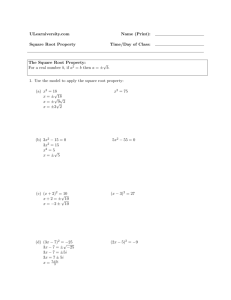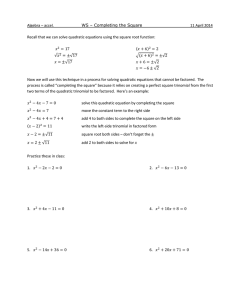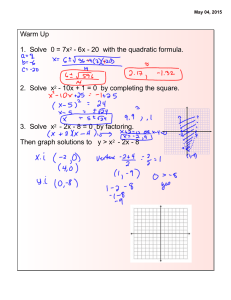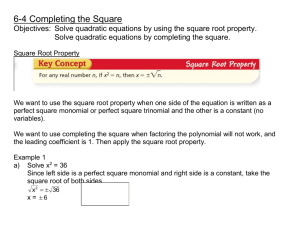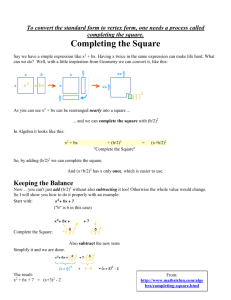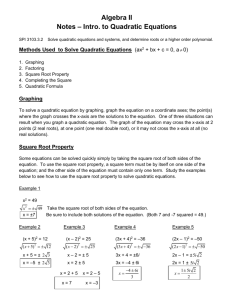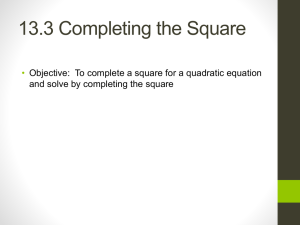11.2 Solving Quadratic Equations by Completing the Square
advertisement
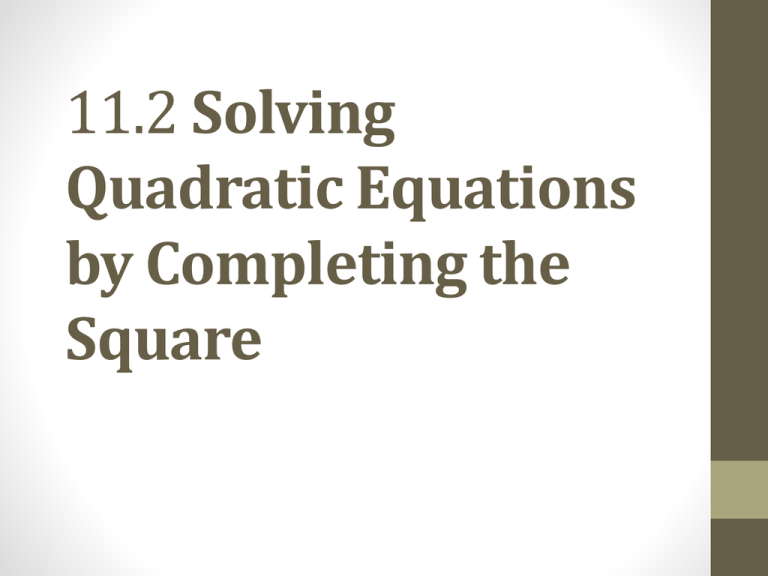
11.2 Solving Quadratic Equations by Completing the Square Objective 1 Solve quadratic equations by completing the square when the coefficient of the second-degree term is 1. Slide 11.2-3 Solve quadratic equations by completing the square when the coefficient of the second-degree term is 1. The methods studied so far are not enough to solve the equation x2 + 6x + 7 = 0. If we could write the equation in the form (x + 3)2 equals a constant, we could solve it with the square root property discussed in Section 11.1. To do that, we need to have a perfect square trinomial on one side of the equation. Recall from Section 5.4 that th perfect square trinomial has the form x2 + 6x + 9 can be factored as (x + 3)2. Slide 11.2-4 Solve quadratic equations by completing the square when the coefficient of the second-degree term is 1. (cont’d) The process of changing the form of the equation from x2 + 6x + 7 = 0 to (x + 3)2 = 2 is called completing the square. Completing the square changes only the form of the equation. Completing the square not only provides a method for solving quadratic equations, but also is used in other ways in algebra (finding the coordinates of the center of a circle, finding the vertex of a parabola, and so on). Slide 11.2-5 CLASSROOM EXAMPLE 1 Rewriting an Equation to Use the Square Root Property Solve x2 – 20x + 34 = 0. Solution: x 2 20 x 34 x 2 20 x _____ x 2 20 x 100 34 100 2kx 20x x 10 2 66 x 10 66 or x 10 66 x 10 66 or 10 x 10 66 66 2k 20 k 10 k 2 100 Slide 11.2-6 CLASSROOM EXAMPLE 2 Completing the Square to Solve a Quadratic Equation Solve x2 + 4x = 1. Solution: x2 4 x 1 x2 4 x 4 1 4 x 2 2 5 x2 5 x 2 5 or x 2 5 2 5 Slide 11.2-7 Solve quadratic equations by completing the square when the coefficient of the second-degree term is 1. Completing the Square To solve ax2 + bx + c = 0 (a ≠ 0) by completing the square, use these steps. Step 1 Be sure the second-degree (squared) term has coefficient 1. If the coefficient of the squared term is one, proceed to Step 2. If the coefficient of the squared term is not 1 but some other nonzero number a, divide each side of the equation by a. Step 2 Write the equation in correct form so that terms with variables are on one side of the equals symbol and the constant is on the other side. Step 3 Square half the coefficient of the first-degree (linear) term. Slide 11.2- 7 Solve quadratic equations by completing the square when the coefficient of the second-degree term is 1. Completing the Square (continued) Step 4 Add the square to each side. Step 5 Factor the perfect square trinomial. One side should now be a perfect square trinomial. Factor it as the square of a binomial. Simplify the other side. Step 6 Solve the equation. Apply the square root property to complete the solution. Steps 1 and 2 can be done in either order. With some equations, it is more convenient to do Step 2 first. Slide 11.2- 8 CLASSROOM EXAMPLE 3 Solving a Quadratic Equation by Completing the Square (a = 1) Solve x2 + 3x – 1 = 0. Solution: x2 + 3x = 1 Completing the square. 2 3 9 4 2 Add the square to each side. x2 9 9 + 3x + = 1 + 4 4 2 3 13 x 2 4 Slide 11.2- 9 CLASSROOM EXAMPLE 3 Solving a Quadratic Equation by Completing the Square (a = 1) (cont’d) Use the square root property. 3 13 x 2 4 3 13 x 2 2 3 13 x 2 Check that the solution set is or or or 3 13 x 2 4 3 13 x 2 2 3 13 x 2 3 13 . 2 Slide 11.2- 10 Objective 2 Solve quadratic equations by completing the square when the coefficient of the second-degree term is not 1. Slide 11.2-12 Solve quadratic equations by completing the square when the coefficient of the second-degree term is not 1. Solving a Quadratic Equation by Completing the Square Step 1: Be sure the second-degree term has a coefficient of 1. If the coefficient of the second-degree term is 1, go to Step 2. If it is not 1, but some other nonzero number a, divide each side of the equation by a. Step 2: Write in correct form. Make sure that all variable terms are on the one side of the equation and that all constant terms are on the other. Step 3: Complete the square. Take half of the coefficient of the first degree term, and square it. Add the square to both sides of the equation. Factor the variable side and combine like terms on the other side. Step 4: Solve the equation by using the square root property. If the solutions to the completing the square method are rational numbers, the equations can also be solved by factoring. However, the method of completing the square is a more powerful method than factoring because it allows us to solve any quadratic equation. Slide 11.2-13 CLASSROOM EXAMPLE 4 Solving a Quadratic Equation by Completing the Square Solve 4x2 + 8x -21 = 0. Solution: 4 x 2 8 x 21 0 21 2 x 2x 0 4 21 2 x 2x 4 21 4 2 x 2x 1 4 4 25 2 x 2x 1 4 x 1 2 25 x 1 4 5 x 1 2 x 3 2 25 4 25 or x 1 4 5 x 1 or 2 or x 7 2 7 3 , 2 2 Slide 11.2-14 CLASSROOM EXAMPLE 5 Solving a Quadratic Equation by Completing the Square (a ≠ 1) Solve 3x2 + 6x – 2 = 0. Solution: 3x2 + 6x = 2 2 2 x 2x 3 Completing the square. 1 2 2 2 1 1 2 2 x 2x 1 1 3 2 5 x 1 3 2 Slide 11.2- 14 CLASSROOM EXAMPLE 5 Solving a Quadratic Equation by Completing the Square (a ≠ 1) (cont’d) Use the square root property. 5 x 1 3 5 x 1 3 15 x 1 3 3 15 x 3 Check that the solution set is or 3 5 x 1 2 3 or 5 x 1 3 15 or x 1 3 3 15 or x 3 3 15 . 3 Slide 11.2- 15 CLASSROOM EXAMPLE 6 Solve for Nonreal Complex Solutions Solve the equation. 5 x 2 15 x 12 0 Solution: 5 x 2 15 x 12 12 2 x 3x 5 Complete the square. 2 9 3 3 4 2 1 2 2 9 12 9 x 3x 4 5 4 2 3 3 x 2 20 2 Slide 11.2- 16 CLASSROOM EXAMPLE 6 Solve for Nonreal Complex Solutions (cont’d) 3 3 x 2 20 3 i 3 5 x 2 20 5 3 i 15 x 2 10 3 3 or x 2 20 3 i 3 5 or x 2 20 5 3 i 15 or x 2 10 3 i 15 3 i 15 x or x 2 10 2 10 3 15 The solution set is i. 2 10 Slide 11.2- 17 Objective 3 Simplify the terms of an equation before solving. Slide 11.2-19 CLASSROOM EXAMPLE 7 Simplifying the Terms of an Equation before Solving Solve (x + 6)(x + 2) = 1. Solution: x 2 8 x 12 1 ( x 4) 5 or ( x 4) 5 x 4 5 or x 4 5 x 2 8 x 16 11 x 8x 16 5 x 4 2 5 4 5 Slide 11.2-20

